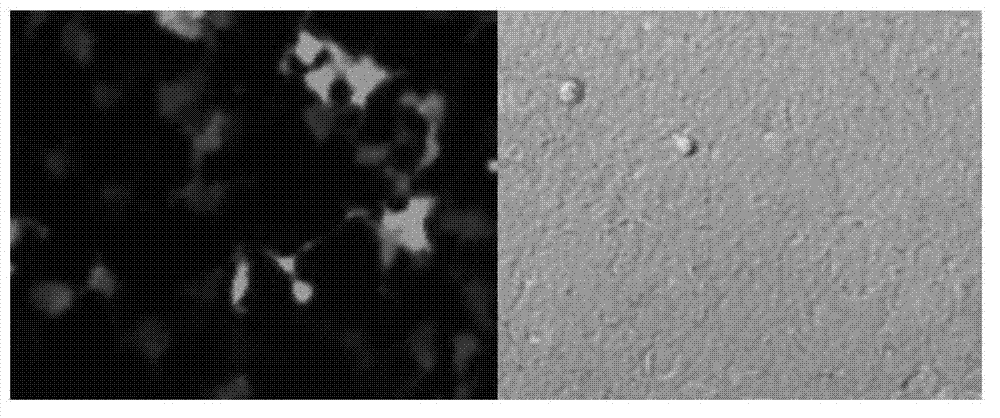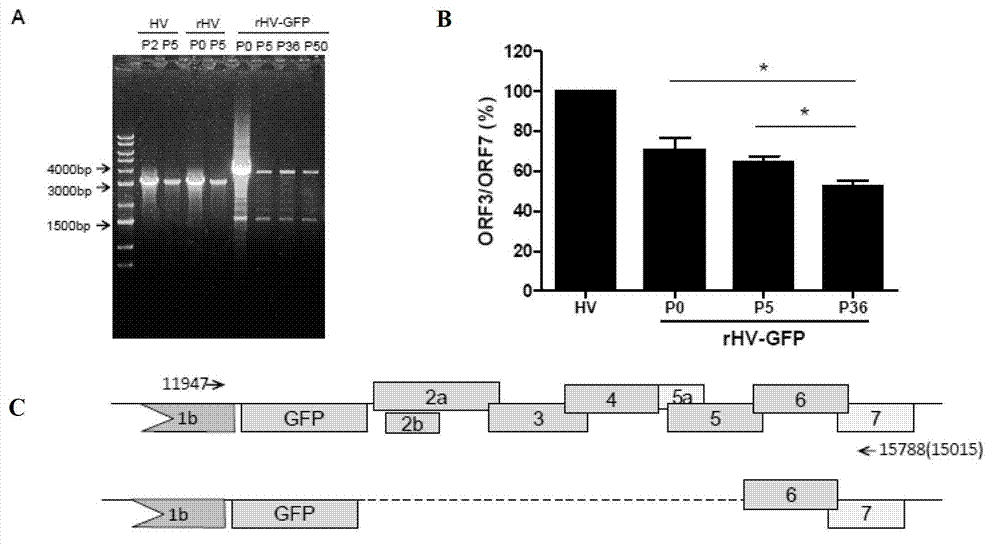Recombinant porcine reproductive and respiratory syndrome virus as well as preparation method and application thereof
A respiratory syndrome and recombinant virus technology, applied in biochemical equipment and methods, antiviral agents, virus antigen components, etc., can solve the problems of strong virulence, general effect, and insufficient protection of highly pathogenic virus strains. Achieve high safety and good preventive effect
- Summary
- Abstract
- Description
- Claims
- Application Information
AI Technical Summary
Problems solved by technology
Method used
Image
Examples
Embodiment 1
[0044] Example 1, Isolation and Identification of Highly Pathogenic Porcine Reproductive and Respiratory Syndrome Virus HV Strains
[0045] 1. Isolation of highly pathogenic porcine reproductive and respiratory syndrome virus HV strain
[0046] In June 2007, the viscera of sick pigs were retrieved from the pig farm where highly pathogenic "PRRS" broke out in Beijing, my country, as disease materials, ground into powder with liquid nitrogen, resuspended by adding appropriate amount of RPMI1640 culture medium, and then frozen and thawed three times , centrifuge to get the supernatant, and then filter with a 0.22 μm filter to obtain the supernatant of the disease material. Inoculate the supernatant into porcine alveolar macrophages (PAMs), culture at 37°C, collect the virus when 60%-80% of the cells show lesions, and continue to passage to obtain the virus supernatant.
[0047] 2. Identification of HV strains of highly pathogenic porcine reproductive and respiratory syndrome viru...
Embodiment 2
[0056] Embodiment 2, the preparation of recombinant porcine reproductive and respiratory syndrome virus
[0057] 1. Construction of recombinant plasmid carrying HV strain genome
[0058] The full-length genome sequence (sequence 1) of the HV strain measured in Example 1 was analyzed, and 6 restriction sites for splicing the full-length genome sequence were selected, namely SmiI, XhoI, AflII, and ClaI , EcoRV and NotI. The full-length genome sequence of the HV strain (sequence 1) contains restriction sites XhoI (3400th and 6901st of sequence 1), AflII (6465th of sequence 1), ClaI (8798th of sequence 1 position) and the recognition sequences of EcoRV (12071st position of sequence 1), but not the recognition sequences of restriction sites SmiI and NotI. The full length of the genome is divided into 5 fragments through the four restriction sites on the genome, and the restriction sites SmiI and NotI are added to the two ends of the viral genome respectively, and then the 5 fragm...
experiment example 3
[0094] Experimental example 3, the comparison of three kinds of virus in vitro traits
[0095] The wild-type virus HV (WT), the virus rHV (CK) rescued from the recombinant plasmid pcDNA3.1M-HV, and the attenuated vaccine rHV-GFP rescued from the recombinant plasmid pcDNA3.1M-△HV-GFP (experimental group) Inoculate alveolar macrophages (porcine alveolar macrophages, PAMs) with the same toxic dose (MOI=0.1). Among them, the wild-type virus HV (WT) adopts the fifth generation (P5), the virus rHV (CK) adopts the fifth generation (P5), and the attenuated vaccine rHV-GFP (experimental group) adopts the fifth generation (P5). After that, the following two aspects of detection are carried out:
[0096] 1. Determination of virus titer
[0097] Cell supernatants were collected 12 hours, 24 hours, 36 hours and 48 hours after virus inoculation. The cell supernatant was serially diluted 10 times and inoculated into alveolar macrophages cultured in a 96-well plate to detect the virus tite...
PUM
 Login to View More
Login to View More Abstract
Description
Claims
Application Information
 Login to View More
Login to View More - R&D
- Intellectual Property
- Life Sciences
- Materials
- Tech Scout
- Unparalleled Data Quality
- Higher Quality Content
- 60% Fewer Hallucinations
Browse by: Latest US Patents, China's latest patents, Technical Efficacy Thesaurus, Application Domain, Technology Topic, Popular Technical Reports.
© 2025 PatSnap. All rights reserved.Legal|Privacy policy|Modern Slavery Act Transparency Statement|Sitemap|About US| Contact US: help@patsnap.com



